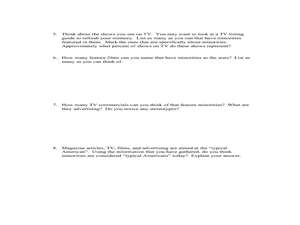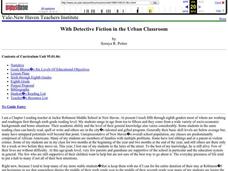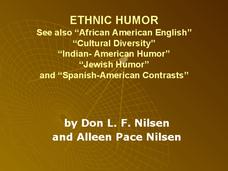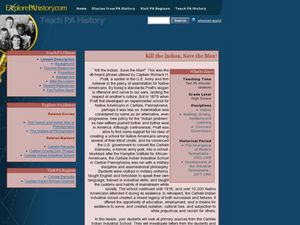Curated OER
Knowledge is Power
Students explore the distinct forms of knowledge that enslaved Africans brought with them to America or developed while enslaved. They study how political movements of the 18th century helped develop abolitionist thinking.
Curated OER
Dubois and Washington Venn Diagram
Students compare and contrast the visions of W.E.B. Dubois and Booker T. Washington. In this African American history lesson, students read biographies about both men and create a Venn diagram about the men.
Curated OER
Jackie Steals Home
Students read articles relating to Jackie Robinson's breaking of the racial barrier in professional baseball. This leads to a deeper exploration of racism in the United States. They use a variety of worksheets imbedded in this plan to...
Curated OER
"ART ZOO 'Blacks in the Westward Movement', 'What Can You Do with a Portrait', and 'Of Beetles, Worms, and Leaves of Grass'"
Students study black history, examine portraits and portrait making and create their own portraits, and investigate their natural environment. This humanities instructional activity provides a text that can be used to teach lessons in...
Curated OER
The Roaring Twenties
In this Roaring Twenties Era worksheet, young scholars review a chapter as they identify 5 vocabulary terms or individuals quotes, eliminate 4 false statements, and identify 2 themes from the era of great change in the United States.
Curated OER
The Slave Trade
Students map and explore a possible slave trade route. In this slave trade mapping lesson, students calculate the distance and amount of time it would take for African slaves to arrive in America.
Curated OER
East to West: Africa's Influence on Mexico
Your historians and social anthropologists study the relationship between peoples of ancient Africa and ancient Mesoamerica. They relate in written or verbal form the African presence in the ancient Americas. They create their own...
Curated OER
Early American Immigration and Race
Young scholars examine and define the different types of immigration. Using different documents, they identify types of migration. In groups, they compare and contrast the migration experiences of the Africans and the British. They...
Curated OER
Marketing Class
Learners study social class, status, and role in America while examining how sociologists determine the criteria for these concepts. They apply these concepts to their own surroundings. They look at images of people and discuss what...
Constitutional Rights Foundation
History of Immigration Through the 1850s
Everyone living in the United States today is a descendant from an immigrant—even Native Americans. Learn about the tumultuous history of American immigration with a reading passage that discusses the ancient migration over the Bering...
Curated OER
The Two-Party System: Chapter 5
Guide your students' reading with this worksheet. Included are five matching and five multiple choice questions focused on aspects of the two-party system employed in the United States. Use as a quiz, guided reading questions, or homework.
K12 Reader
Broken Promises
This comprehension worksheet asks readers to respond to a series of questions based on an article about the treatment of native peoples.
Curated OER
Minorities in Mainstream American Society
So many people fought for Civil Rights in the United States. Read about the Civil Rights Act of 1964, and discuss what the act guarantees. Then pass out a slew of magazines and encourage them to observe how often minorities appear in...
Curated OER
With Detective Fiction in the Urban Classroom
This abstract for an instructional unit using three-minute mysteries, stories by Sir Arthur Canon Doyle, and Edgar Allan Poe includes a short history of detective fiction, sample plans, and suggestions for exercises and activities...
Curated OER
Ethnic Humor
Uncovering the function and forms of ethnic jokes, this presentation with enlighten your students as it explores the concept of "insiders vs. outsiders" and various examples of ethnic stereotypes in literature and society. The...
Center for History Education
To What Extent Were Women's Contributions to World War II Industries Valued?
Women rose to the challenge when the nation's war effort called them—but were sent home when the GIs came back from World War II. Young historians consider whether the United States valued women's contributions during the war using a...
Curated OER
Jazz's Beginnings
Learners examine jazz's roots and their hybridization in New Orleans in the early 20th century. They listen to ragtime and jazz recordings, then complete worksheets imbedded in this plan.
Curated OER
South Asian Architecture
Seventh graders review and discuss architecture from South Asia. They then study images of various buildings from North Africa/Southwest Asia, and make comparisons
Curated OER
Uniform Design
Learners investigate the military by examining their uniforms. In this design lesson, students analyze the military uniforms from different locations and time periods. Learners create new ideas for current military uniforms.
Curated OER
Kill the Indian, Save the Man!
Students investigate primary sources from Carlisle Indian School including letters and photographs. In this investigative lesson students answer questions about their research.
Curated OER
Revolutionary Money
Examine paper money from the American revolution! Historians study the paper bills and discuss the history of money. How has money changed over the times? Activities are included.
Smithsonian Institution
Watching Crystals Grow
Amazing science can sometimes happen right before your eyes! The class gets cozy as they watch crystals grow. They use Epsom salts, rocks, and food coloring to create crystals. They'll observe the entire process, documenting every step...
Curated OER
Meet the Underground Railroad
Students research and learn about the Underground Railroad. In this Underground Railroad lesson plan, students take 2 weeks to research an individual, complete journal writings, read passages in small groups, list major events, and more.
Curated OER
American Music Styles - Lesson 1
Learners describe some of the distinguishing characteristics of rock, folk, blues, and country music. They identify two main musical roots of today's American popular music.

























